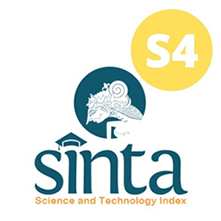Effectiveness of Green Mussel Shells as a Natural Coagulant for Domestic Wastewater Treatment
Abstract
Coagulation is one of the wastewater treatment processes. Aluminum sulfate is usually used as a chemical coagulant. On the other way, the use of alum can cause a new problem that was the inorganic residues produced are carcinogenic and can harm the environment and human health. Then people try to use natural materials such as chitosan as the coagulant. Chitosan can be produced from the skin of marine animals such as green mussels. This study aimed to determine the effectiveness of natural coagulant green mussel shells. The research method was an experimental study by testing the effectiveness of green mussel shells as a natural coagulant with one group post design. This research used small dose of chitosan that is 0,15 g/l until 0,4 g/l to know which one is the most effective to reduce turbidity and suspended solid. The sample in this study was domestic wastewater. The parameters were total suspended solids (TSS) and turbidity. The data were analyzed by the ANOVA test. The result showed that both TSS and turbidity were decreased by about 100% (14 mg/l to 0,65 mg/l) for optimum decreasing of TSS parameter and 73% (2.38 NTU to 0 NTU) for turbidity parameters. The optimal dose of natural coagulant green mussel shells for domestic wastewater was 0,4 g/l. The ANOVA test showed that there was an effect of green mussel shells coagulant dose on TSS and turbidity level (p-value = 0,000). The potential of using these green mussel shells as a coagulant is indeed very high. However, it takes a combination with other natural ingredients to make an effective and safe coagulant.

This work is licensed under a Creative Commons Attribution-ShareAlike 4.0 International License.
Authors who publish with this journal agree to the following terms:
- Authors retain copyright and grant the journal right of first publication with the work simultaneously licensed under a Creative Commons Attribution License that allows others to share the work with an acknowledgement of the work's authorship and initial publication in this journal.
- Authors are able to enter into separate, additional contractual arrangements for the non-exclusive distribution of the journal's published version of the work (e.g., post it to an institutional repository or publish it in a book), with an acknowledgement of its initial publication in this journal.
- Authors are permitted and encouraged to post their work online (e.g., in institutional repositories or on their website) prior to and during the submission process, as it can lead to productive exchanges, as well as earlier and greater citation of published work (See The Effect of Open Access).











